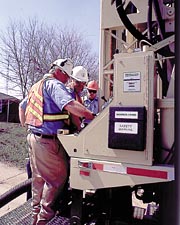
Today’s drill rigs are much safer than the industry standard even 10 years ago. Hydraulic motors, which are more powerful and safer than moving heavy equipment with chains, cables and belts, do most of the work. In the past, one of the qualifications to be a driller or especially a helper was size and strength of the individual. Today, it is possible to be a 90-pound weakling and lift and tighten drill rods and move other heavy objects.
Environmental drilling at industrial sites, for example, can be an eye-opening experience for a driller the first time. Extreme measures are being taken (a good thing) to ensure the safety of everyone at the plant. Before a drilling firm can drill at many facilities, the company’s safety records are closely scrutinized, and if worker compensation claims are too high, then the contractor may not be allowed to work on the site. I actually have had drilling firms rejected because of their accident claims history. The claims experience reviewed often includes the claims of all workers in your office, even personnel that never go to a drilling site.
Drilling is inherently risky because drilling under different conditions each day, the proximity to overhead power lines and underground utilities and the hard physical work of drilling often under fatigue and tight deadlines contribute to the occurrence of accidents. We must observe, analyze and constantly change the way we do things to make the workplace as safe of a place to work as possible.
The drilling equipment manufacturing industry must continue to improve driller safety because many employees and prospective employees are safety-conscious; OSHA demands it as well. We must face the fact that this and future generations of drillers and helpers, given a choice to work long, hard hours away from their families, working at hazardous waste sites and under unsafe conditions, will chose to work at a lot of other places for less money if we can’t improve the safety of our work environment.
The good news is that, I would venture to say, the average driller today has more fingers per hand and better hearing than those of a generation ago, and that’s a good thing.






Report Abusive Comment